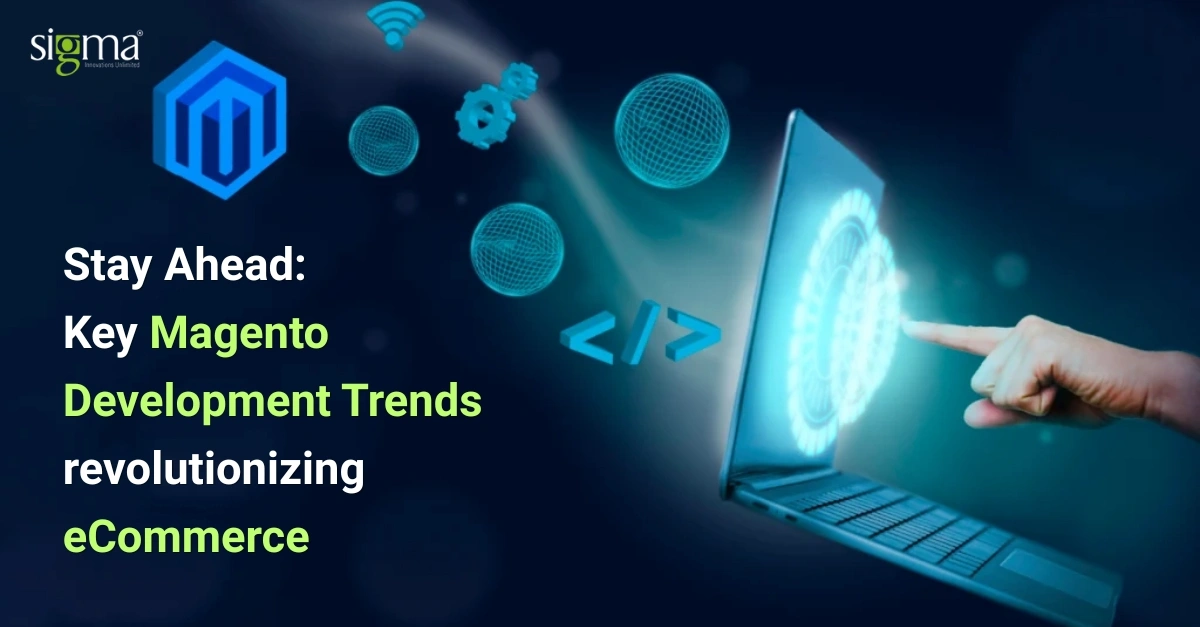Stay Ahead: Key Magento / Adobe Commerce Development Trends Revolutionizing eCommerce

The eCommerce landscape is evolving at breakneck speed, and businesses need to stay ahead of the curve to remain competitive. In today’s evolving eCommerce environment, solutions built around Magento are being shaped by revolutionary trends that are transforming how online stores operate and engage with customers. These emerging patterns in eCommerce solutions are not just technological upgrades; they are fundamental shifts that are redefining the entire shopping experience.
Let’s explore the key Magento development trends that are revolutionizing the eCommerce industry and discover how they can propel your business to new heights.

1. Hyper-Personalization with AI: The New Standard for Customer Experience
Artificial Intelligence has moved beyond simple product recommendations to deliver truly personalized shopping experiences. Modern eCommerce magento development leverages AI algorithms to analyze customer behavior patterns, purchase history, and browsing preferences to create individualized storefronts for each visitor.
Key AI-Driven Personalization Features:
- Dynamic Content Customization: AI algorithms automatically adjust homepage layouts, product displays, and content based on individual user preferences and behavior patterns.
- Predictive Product Recommendations: Advanced machine learning models analyze vast datasets to predict what customers are likely to purchase next, substantially boosting conversion rates.
- Intelligent Search Functionality: AI-powered search engines understand natural language queries and deliver contextually relevant results, even for misspelled or incomplete searches.
The impact is significant: businesses implementing AI-driven personalization report average increases of their conversion rates and improvement in customer engagement.
2. Sustainability Features: Meeting the Green Commerce Demand
Environmental consciousness is no longer a niche concern—it’s a mainstream expectation. Modern consumers actively seek out businesses that demonstrate genuine commitment to sustainability, and Magento development is responding with innovative green commerce features.
Sustainable eCommerce Solutions Include:
- Carbon Footprint Tracking: Integrated tools that calculate and display the environmental impact of purchases, shipping methods, and packaging choices.
- Eco-Friendly Product Filtering: Advanced search filters that help customers identify sustainable products based on certifications, materials, and environmental impact scores.
- Green Shipping Options: Integration with eco-friendly delivery services and carbon offset programs that allow customers to make environmentally conscious shipping choices.
Companies implementing sustainability features report not only improved brand perception but also increased customer loyalty and higher average order values, as environmentally conscious consumers are often willing to pay premium prices for sustainable options.
Collaborate with Sigma Infosolutions, a Magento development company, for all your eCommerce needs!
3. Dynamic Pricing Strategies: Real-Time Market Responsiveness
The era of static pricing is over. Dynamic pricing strategies powered by sophisticated algorithms allow Magento stores to adjust prices in real-time based on multiple factors including demand, competition, inventory levels, and customer segments.
Advanced Dynamic Pricing Components:
- Demand-Based Pricing: Algorithms that increase prices during high-demand periods and offer discounts during slower times to optimize revenue and inventory turnover.
- Customer Segment Pricing: Personalized pricing tiers based on customer loyalty levels, purchase history, and engagement metrics.
- Inventory-Driven Pricing: Automatic price adjustments based on stock levels, helping to clear excess inventory while maximizing profit margins on high-demand items.
Businesses using dynamic pricing strategies report significant revenue increases and improved inventory management efficiency.
4. Visual Merchandising: Creating Immersive Shopping Experiences
Visual merchandising has evolved far beyond simple product photography. eCommerce magento development incorporates cutting-edge visual technologies that create immersive, engaging shopping experiences that bridge the gap between online and physical retail.
Next-Generation Visual Features:
- Augmented Reality (AR) Integration: Customers can visualize products in their own spaces using AR technology, dramatically reducing return rates and increasing purchase confidence.
- 360-Degree Product Views: Interactive product displays that allow customers to examine items from every angle, providing the thorough inspection experience of physical shopping.
- Virtual Try-On Capabilities: Advanced AR and AI technologies that enable customers to virtually try on clothing, accessories, makeup, and eyewear before purchasing.
These visual enhancements not only improve customer satisfaction but also significantly reduce return rates and increase average order values.
5. Omni-Channel & Voice Commerce Integration: Seamless Shopping Across All Touchpoints
The boundaries between different shopping channels continue to blur. Technologies such as artificial intelligence, voice commerce, and mobile solutions will be critical to staying ahead of the curve.
Comprehensive Omni-Channel Features:
- Unified Customer Profiles: Centralized customer data that provides consistent experiences across web, mobile, social media, and physical store locations.
- Cross-Channel Inventory Management: Real-time inventory synchronization across all sales channels, preventing overselling and ensuring accurate stock information.
- Voice Commerce Integration: Compatibility with smart speakers and voice assistants, allowing customers to place orders, track shipments, and get product information through voice commands.
Businesses with strong omni-channel strategies retain 89% of their customers compared to 33% for companies with weak omni-channel approaches.
6. Headless Commerce with PWA: The Future of Flexible eCommerce Architecture
The Magento development scenario continues to be dominated by Progressive Web Applications (PWAs). Due to the fast, responsive, and engaging experiences they offer across devices, the adoption of PWAs is expected to accelerate substantially in the near future. Headless commerce architecture combined with Progressive Web Apps represents the pinnacle of modern eCommerce development.
Headless Commerce Advantages:
- Unprecedented Flexibility: Headless commerce is a separation of the front end and back end of an eCommerce application. This architecture allows freedom of expression and enables brands to create whatever they want, however they want.
- Superior Performance: Headless Magento allows developers to implement SEO best practices more effectively using server-side rendering (SSR) and progressive web apps (PWA).
- Future-Proof Technology Stack: The ability to update frontend and backend independently ensures your eCommerce platform can adapt to new technologies without complete overhauls.
PWA Benefits:
- App-Like Performance: Lightning-fast loading times and smooth interactions that rival native mobile applications.
- Offline Functionality: Customers can browse products and access cached content even without internet connectivity.
- Enhanced SEO: Better search engine visibility and improved page speed scores.
Read the blog to know more about why Progressive Web Apps (PWAs) are considered a game-changer for eCommerce businesses.
Implementation Strategies for Modern Magento Development
Successfully implementing these trends requires strategic planning and expert execution. Here’s how businesses can approach modernizing their Magento stores:
Step 1: Assessment and Planning Begin with a comprehensive audit of your current eCommerce platform, identifying areas where these trends can have the most significant impact.
Step 2: Technology Integration Work with experienced Magento developers to integrate AI-powered personalization tools, implement headless architecture, and develop PWA capabilities.
Step 3: Testing and Optimization Conduct thorough testing across all devices and platforms. Use A/B testing to measure the effectiveness of new features and continuously optimize based on user feedback and performance metrics.
Step 4: Monitoring and Improvement Implement comprehensive analytics to track the performance of new features. Monitor key metrics such as conversion rates, page load times, customer engagement, and return rates to ensure continuous improvement.
Conclusion: Your Path to eCommerce Excellence
The future of eCommerce is being written today, and these Magento development trends are the authors of that future. By partnering with an experienced Magento development company and implementing these cutting-edge eCommerce solutions, you are not just updating your online store—you are future-proofing your business for sustained growth and success in the competitive digital marketplace.
Ready to build your dream eCommerce store? Discover the platform that fits your business best — and let Sigma Infosolutions bring your vision to life. Talk to our eCommerce experts today!
